Join us as we visit some standout Albuquerque GSI/LID projects. We’ll provide the transportation and a delicious lunch!
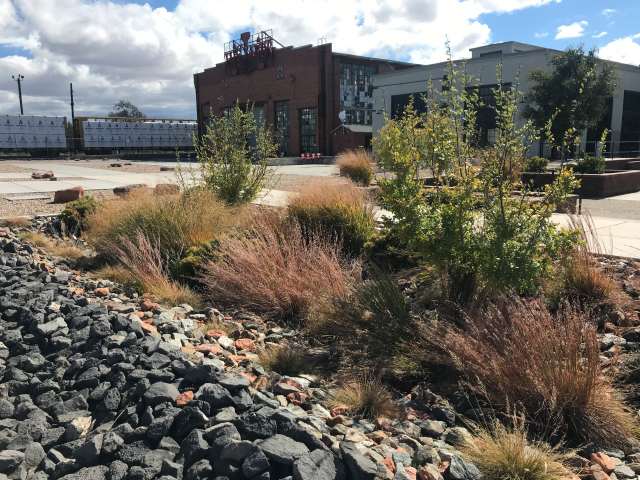
RAILYARDS MARKET • CITY OF ALBUQUERQUE, MRWM
The Albuquerque Railyards Event Space is a flexible-use space that further activates the Railyards district. The space includes areas for stages, food trucks, seating, and gathering, creating a prime venue for various event types and sizes. The design retains unique elements of this historical place while adding Railyards-inspired elements such as the turn table and grey pavers. Most design elements are removable and reusable to allow the space to change with future development. In addition to creating an event space, the design responsibly manages the stormwater runoff resulting from the new asphalt parking lot with a stormwater harvesting basin and on-site detention capability.
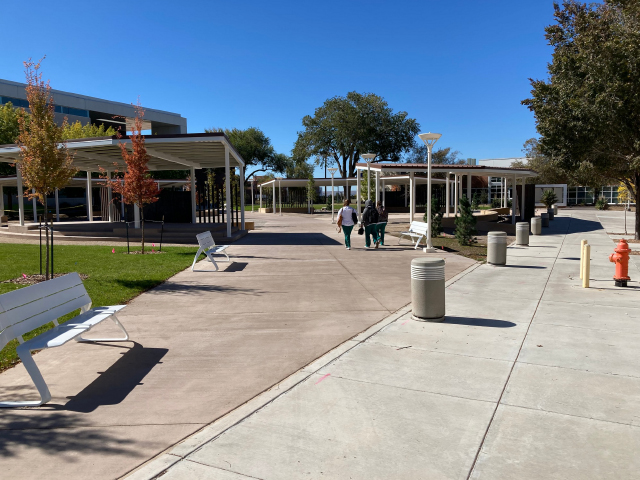
CNM STUDENT RESOURCE CENTER PLAZA • CNM (Adrianna Casas), SITES SOUTHWEST
One of the newest additions to the Central New Mexico Community College (CNM) campus is the Student Resource Center. This beautiful modern multipurpose building creates a center for student life and an expansive outdoor area in the heart of the CNM campus. The building marries outdoor and indoor spaces with an open-air walkthrough. It provides students with a library, food court, and other amenities in both the interior and exterior of the building. However, the former expansive lawn to its south was removed and replaced with dark gray crushed gravel, leaving it inhospitable during much of the year. Sites Southwest was retained to reimagine the space as a student gathering and event venue. The site and landscape were designed to complement the features of the building and provide a large central plaza that will accommodate campus events while bringing new life to what was previously a barren expanse of gravel. The design also creates several shaded sitting areas for student use, as well as a stage with a new, smaller-scale lawn for hosting concerts and presentations. Great care was taken to save existing shade trees to the south of the plaza to provide respite and create a more settled and mature landscape. Onsite drainage is accommodated through a permeable paver system in the central plaza and a subsurface infiltration system that uses perforated pipe to distribute offsite runoff to the root zones of new trees in that plaza. Plants were selected for local climate conditions and drought tolerance while adding varied color, texture, and shade.
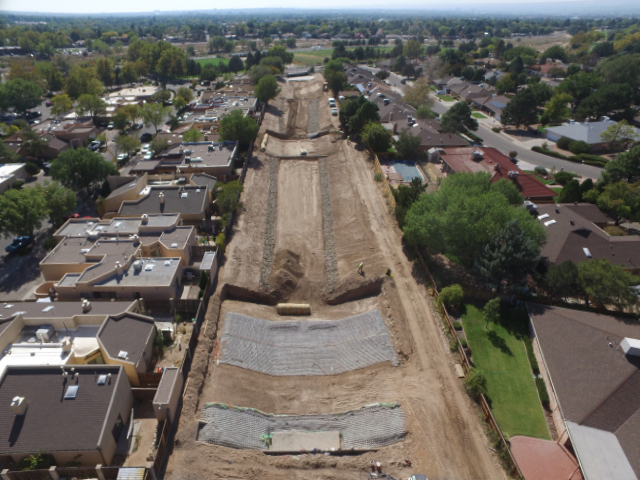
THE LOWER BEAR TRIBUTARY ARROYO REGIONAL WATER QUALITY FACILITY • AMAFCA
AMAFCA implemented the Lower Bear Tributary Arroyo Regional Water Quality Facility to protect the water quality of the Rio Grande and the aquifer located below the City of Albuquerque. It features a multi-part stormwater treatment train. As stormwater runoff from rainfall events moves through this arroyo – from Wyoming Blvd. to Spain Rd. – it passes through a series of controls, each designed to remove pollutants from the stormwater. The “cars” in this treatment train each feature different components of stormwater quality enhancement techniques.
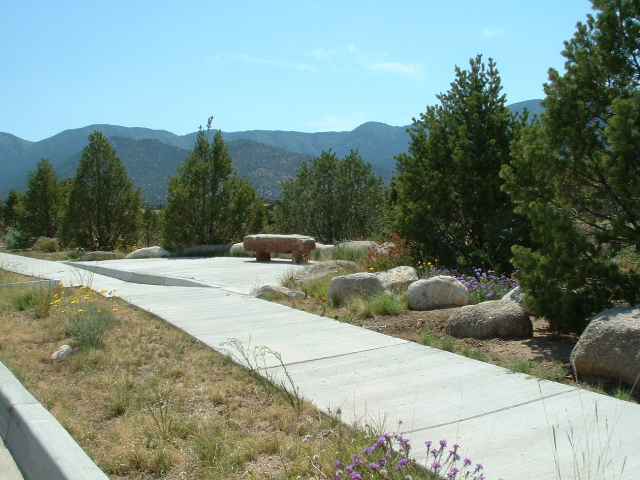
HIGH DESERT COMMUNITY CENTER • SITES SW
Sites Southwest completed master planning and design for this 1,400-acre parcel in the foothills of Albuquerque, New Mexico. The development encompasses about 2,300 dwelling units built over a 14-year period, with 30% of the land saved for open space and conservation. High Desert had the foresight to plan and design a community that held Water Conservation in the highest regard. All precipitation runoff is harvested into streetscapes, landscapes, parks, and open spaces to create a truly sustainable landscape for the community. Sites Southwest developed the approved plant list and landscape revegetation guidelines, designed almost all of the landscapes, and was a member of the community review committee. The landscapes are drought tolerant; almost all utilize native plants and harvested water from roadways, rooftops, and other impermeable surfaces. All materials were also selected for sustainability and come from within 50 miles of the community. To lessen the impact on the environment, the native landscape was protected and enhanced through passive gravity irrigation. This system provides a means of using moisture that would otherwise be lost and provides the community with a demonstration of innovative alternative technology.
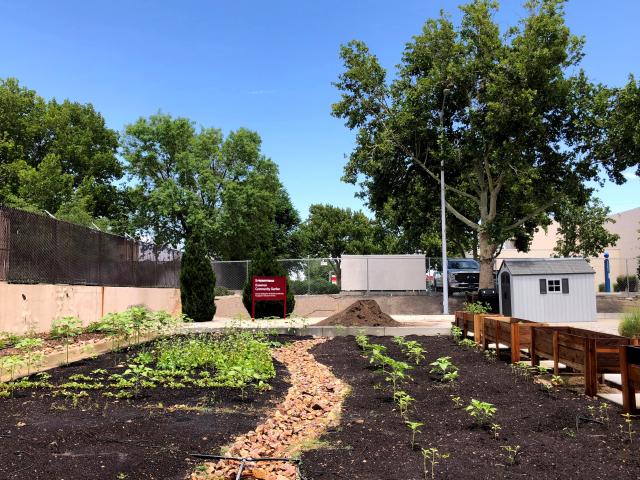
PRESBYTERIAN KASEMAN COMMUNITY HEALTH RESOURCE CENTER GARDEN • GROUNDWORK STUDIOS, ADAPTIVE TERRAIN SYSTEMS
In partnership with Bernalillo County, the International District Healthy Communities Coalition, and over 20 public and private stakeholder groups, our team developed a process for the County to support sustained urban agriculture in one of Albuquerque’s most economically and culturally diverse urban neighborhoods. Through comprehensive inventory, community-assisted asset mapping, hands-on community engagement, and the design and implementation of nine separate priority urban agriculture sites, the project team developed an adaptable framework for the County to support a wide range of existing and proposed community-based urban agriculture efforts. One of the nine priority sites that were designed and constructed during this process, the Kaseman Community Garden project presented an incredible opportunity to both improve the quality and sustainability of their garden design while also providing an invaluable demonstration for the community in soil remediation, water harvesting, and long-term urban garden design elements.
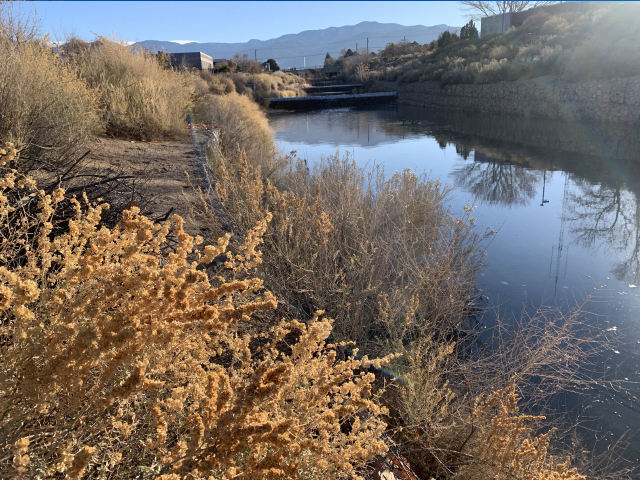
BEAR CANYON AQUIFER RECHARGE PROJECT
The Water Authority’s managed aquifer recharge project, Bear Canyon Recharge, was initiated in 2007 as a demonstration phase project. It involves bank-filtered recharge of San Juan-Chama surface water into the Bear Canyon Arroyo channel at the Arroyo del Oso Park. The SJC water is diverted from the Rio Grande and conveyed to the discharge location via distribution piping for the Water Authority’s North Non-Potable irrigation system. Recharge occurs during the Winter months (October to March), and the volume of water recharged is dependent on SJC water quantities available under the Water Authority’s surface water permit SP-4819. The Bear Canyon Recharge was the first full-scale recharge project permitted in New Mexico and has the potential to recharge up to 3,000 acre-feet per year. It currently has 1,770 acre-feet of recoverable water under the Underground Storage and Recovery (USR) permit (USR-2) with the Office of the State Engineer.

